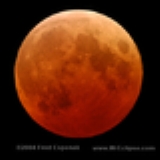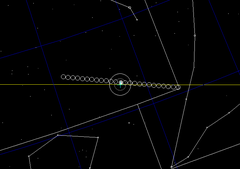
October 2004 lunar eclipse
Encyclopedia
| Total Lunar Eclipse October 27–28, 2004 http://eclipse.gsfc.nasa.gov/LEplot/LEplot2001/LE2004Oct28T.pdf |
|
|---|---|
 Fred Espenak Fred Espenak Fred Espenak is an American astrophysicist. He works at the Goddard Space Flight Center. He is best known for his work on eclipse predictions.... , 3:03 UT Dunkirk, MD |
|
 The moon's path through the Earth's shadow. |
|
| Series (and member) Saros cycle The saros is a period of 223 synodic months , that can be used to predict eclipses of the Sun and Moon. One saros after an eclipse, the Sun, Earth, and Moon return to approximately the same relative geometry, and a nearly identical eclipse will occur, in what is referred to as an eclipse cycle... |
136 (19) |
| Duration (hr:mn:sc) | |
| Totality | 01:21:14 |
| Partial | 03:39:20 |
| Penumbral | 05:57:08 |
| Contacts | |
| P1 | 00:05:35 UTC |
| U1 | 01:14:26 UTC |
| U2 | 02:23:28 UTC |
| Greatest | 03:04:07 UTC |
| U3 | 03:44:43 UTC |
| U4 | 04:53:45 UTC |
| P4 | 06:02:44 UTC |
 The moon's path across shadow in Aries. |
|
A total lunar eclipse
Lunar eclipse
A lunar eclipse occurs when the Moon passes behind the Earth so that the Earth blocks the Sun's rays from striking the Moon. This can occur only when the Sun, Earth, and Moon are aligned exactly, or very closely so, with the Earth in the middle. Hence, a lunar eclipse can only occur the night of a...
took place on October 28, 2004, the second of two total lunar eclipses in 2004, the first being on May 4, 2004
May 2004 lunar eclipse
A total lunar eclipse took place on May 4, 2004, the first of two total lunar eclipses in 2004, the second being on October 28, 2004.- Visibility :...
.
Visibility
This eclipse was completely visible from all of North and South America, and visible from most of Europe and Africa.
Lunar year series
It is the third of four lunar year cycles, repeating every 354 days.Saros series
This eclipse is a part of Saros cycleSaros cycle
The saros is a period of 223 synodic months , that can be used to predict eclipses of the Sun and Moon. One saros after an eclipse, the Sun, Earth, and Moon return to approximately the same relative geometry, and a nearly identical eclipse will occur, in what is referred to as an eclipse cycle...
136, and the first of the series that passes through the center of the Earth's shadow. The next occurrence will be on November 8, 2022
November 2022 lunar eclipse
A total lunar eclipse will take place on November 8, 2022. The moon will pass through the center of the Earth's shadow.-Visibility:It will be completely visible over the Pacific, and most of North America, will be seen rising over Australia and Asia, and setting over South America and eastern North...
.
Metonic series
This eclipse is the third of four Metonic cycleMetonic cycle
In astronomy and calendar studies, the Metonic cycle or Enneadecaeteris is a period of very close to 19 years which is remarkable for being very nearly a common multiple of the solar year and the synodic month...
lunar eclipses on the same date, October 28–29, each separated by 19 years:
See also
- List of lunar eclipses and List of 21st century lunar eclipses
- May 2003 lunar eclipseMay 2003 lunar eclipseA total lunar eclipse took place on May 16, 2003, the first of two total lunar eclipses in 2003, the other being on November 9, 2003.- Saros series :It is a member of Saros cycle 121.- Lunar year series :...
- November 2003 lunar eclipseNovember 2003 lunar eclipseA total lunar eclipse took place on November 9, 2003, the second of two total lunar eclipses in 2003, the first being on May 16, 2003.-Photo gallery:-Lunar year series:It is the second of four lunar year cycles, repeating every 354 days....
- May 2004 lunar eclipseMay 2004 lunar eclipseA total lunar eclipse took place on May 4, 2004, the first of two total lunar eclipses in 2004, the second being on October 28, 2004.- Visibility :...

